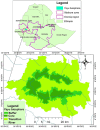The accuracy of species-specific allometric equations for estimating aboveground biomass in tropical moist montane forests: case study of Albizia grandibracteata and Trichilia dregeana
- PMID: 31858282
- PMCID: PMC7227094
- DOI: 10.1186/s13021-019-0134-8
The accuracy of species-specific allometric equations for estimating aboveground biomass in tropical moist montane forests: case study of Albizia grandibracteata and Trichilia dregeana
Abstract
Background: Application of allometric equations for quantifying forests aboveground biomass is a crucial step related to efforts of climate change mitigation. Generalized allometric equations have been applied for estimating biomass and carbon storage of forests. However, adopting a generalized allometric equation to estimate the biomass of different forests generates uncertainty due to environmental variation. Therefore, formulating species-specific allometric equations is important to accurately quantify the biomass. Montane moist forest ecosystem comprises high forest type which is mainly found in the southwestern part of Ethiopia. Yayu Coffee Forest Biosphere Reserve is categorized into Afromontane Rainforest vegetation types in this ecosystem. This study was aimed to formulate species-specific allometric equations for Albizia grandibracteata Tuab. and Trichilia dregeana Sond. using the semi-destructive method.
Results: Allometric equations in form of power models were developed for each tree species by evaluating the statistical relationships of total aboveground biomass (TAGB) and dendrometric variables. TAGB was regressed against diameter at breast height (D), total height (H), and wood density (ρ) individually and in a combination. The allometric equations were selected based on model performance statistics. Equations with the higher coefficient of determination (adj.R2), lower residual standard error (RSE), and low Akaike information criterion (AIC) values were found best fitted. Relationships between TAGB and predictive variables were found statistically significant (p ≤ 0.001) for all selected equations. Higher bias was reported related to the application of pan-tropical or generalized allometric equations.
Conclusions: Formulating species-specific allometric equations is found important for accurate tree biomass estimation and quantifying the carbon stock. The developed biomass regression models can be applied as a species-specific equation to the montane moist forest ecosystem of southwestern Ethiopia.
Keywords: Afromontane rainforest; Model comparisons; Scatter plots; Semi-destructive; Species-specific.
Conflict of interest statement
The authors declare no conflict of interest. The funding sponsors had no role in the design of the study; in the data collection, analyses, or interpretation of data; and in the decision to publish the results.
Figures







References
-
- Townsend AR, Cleveland CC, Houlton BZ, Alden CB, White JWC. Multi-element regulation of the tropical forest carbon cycle. Front Ecol Environ. 2011;9(1):9–17. doi: 10.1890/100047. - DOI
LinkOut - more resources
Full Text Sources

